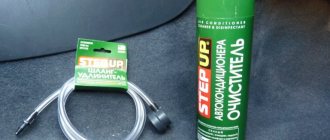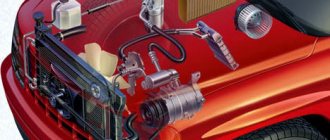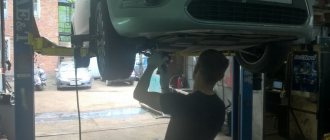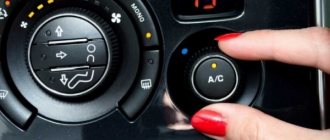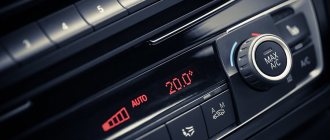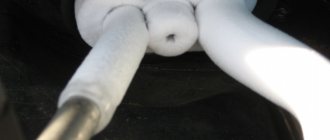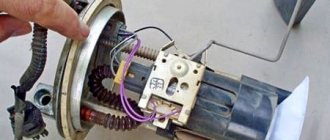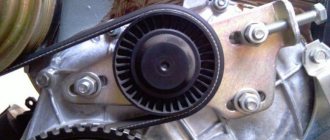Gone are the days when air conditioning in a car was a rarity. Now it is surprising that it is not in the car. If you notice that when you turn on the air conditioner, the air in your car is not as fresh as before, then it is time to clean the air conditioner. If you want to do it yourself, you just need to learn how to clean the air conditioner in your car yourself.
You can view the service coverage map by clicking. Here you can select the service closest to your home or business. Do you think that the efficiency of air conditioning is decreasing every year? Do you need quick air conditioning before your vacation?
How do you know that your car's air conditioning needs attention? Just follow the behavior as it runs. Likewise, any noise from the compressor could indicate a problem. In these cases, an early visit from an expert is advisable. The refrigerant refrigerant is returned with the addition of new compressor oil to the vehicle's air conditioning system and only adds the refrigerant difference to the manufacturer's set point. This means that the customer only covers the difference in the amount of refrigerant that is added to the specified value.
Cause of odor
Of all the elements of a car's ventilation system, the air conditioner evaporator radiator provides the most favorable conditions for the growth and reproduction of bacteria. This happens because the car’s evaporator radiator, like all coolers of this type, has a large surface area to ensure better heat transfer. In addition, when the air conditioner is turned on, its temperature is much lower than the air inside the car, which causes moisture to condense on the radiator. Dust adheres to a large and damp surface, containing many tiny organic residues, which, under conditions of a comfortable temperature (after all, after turning off the air conditioner, the evaporator radiator heats up) and high humidity, begin to rapidly decompose, accompanying the process with a corresponding smell.
Air conditioning disinfection - replacing the cabin filter. The most common air conditioning problems in cars include coolant leaking from the air conditioning circuit. This is facilitated by automakers' attempts to maximize production costs. Due to the load that normal air conditioning operation has, it is impossible to completely close the circuit, and for a small amount of refrigerant leakage occurs with each air conditioner. Some manufacturers claim that up to 30% of the refrigerant weight per year is acceptable.
Operating principle
The air conditioner evaporator is an integral part of a closed freon circuit. Its main function is to cool the air flow driven through it by a fan located directly next to it. The system includes:
- evaporator,
- capacitor,
- fans of external and internal units,
- thermostatic valve,
- compressor,
- copper pipe for refrigerant,
- refrigerant,
- compressor oil.
In a compressor, gaseous freon is compressed into a liquid. Then it passes into an external heat exchanger - a condenser. Here freon gives off its heat to the outside air, which is cooler than the freon substance. Air is forced inside the case by a fan.
Having dropped some of the temperature, the liquid moves further along the circuit and enters the thermostatic valve. Inside the spiral-shaped device, the freon cools even more, and the pressure decreases. In this state, the refrigerant enters the evaporator. When interacting with warm room air (through the heat exchange surface), evaporation occurs, freon goes from liquid to gas state. The air surrounding the heat exchanger is cooled.
Then the gas enters the compressor and the circle resumes. A fan is located next to the evaporator, which promotes the circulation of room air.
How to eliminate odor
You can eliminate the smell from the air conditioner evaporator by either dismantling and washing the evaporator radiator, or cleaning it of bacteria without removing it from its original place. The first cleaning method allows you to clean the evaporator radiator better, but is more labor-intensive, and after assembly, the air conditioner will need to be refilled. You can clean your car air conditioner with your own hands, without disassembling it, using an aerosol or liquid as follows:
This also implies the effectiveness of preventative checks that ensure that the air conditioner actually works. They can also prevent any major breakdown that would require a significantly higher investment. The other main failure category is compressor defects. Due to their extremely complex internal structure, where there are a large number of mechanical components, frictional wear occurs. Incorrect amount or viscosity of special oil will only accelerate this wear.
When replacing any part of the cooling circuit, the specified amount of oil must be added to the manufacturer. This is also very common when, for example, after replacing a damaged cooler, the oil was not refilled and the compressor was severely damaged. If your car's air conditioner doesn't work, or its efficiency decreases within a few days or weeks of being filled, it's most likely due to a coolant leak from the circuit. In this case, it makes no sense to think about new performance, as recommended by the vast majority of "tire experts", whose knowledge in this area simply fills the air conditioning circuit with coolant.
- Dry the air conditioner radiator. To do this, warm up the engine and turn on the interior heater in the car for a few minutes.
- Turn off the heater.
- Remove the cabin filter for the car's fresh air ventilation.
- Open the air intake damper from the street.
- Open all the doors in the car wide open.
- Cover the outlets of the air ducts into the passenger compartment with a loose cloth so that the cleaning agent drips less into the interior of the car.
- Turn on the air conditioner and spray cleaning agent into the hole for the cabin filter.
If you only allow the air conditioner to fill with cooling medium, it will not eliminate the defect, but only the consequences. Therefore, you can very soon expect a decrease in the effect of the air conditioner or complete failure, again due to leakage of the cooling medium. In such cases, it is necessary to first determine the exact location of the air conditioner air leak, stop the leak and, once the air conditioning circuit is sealed, it can be filled with refrigerant.
How to avoid unnecessary expenses? Follow the manufacturer's instructions for air conditioning! Manufacturers recommend checking the system at least once a year. What should your conditioning look like? Detection of dirt or damage to the capacitor.
Prevention of mold formation
The best fight against the formation of fungi and mold is prevention. Care should be taken to prevent the formation of a humid environment for an extended period of time. Air conditioning is carried out by passing a flow of air through a cold evaporator, all the moisture in the air condenses on it. When a large amount of fluid accumulates, it flows through the drain tube outside the vehicle. When the A/C and fan are turned off, a large amount of moisture and bacteria remains on the cold evaporator, which, together with the lack of light, creates a good environment for the formation of mold. When the amount of mold becomes large, an unpleasant odor appears from the air conditioner. Reproduction can be prevented by drying the evaporator after operation. This can be done by turning off the A/C button on the dashboard and leaving the fan on (for a better effect, you can turn on the heater). Warm air will dry out the air conditioner radiator. It is better to do this a few minutes before arriving at your destination (to save time and fuel). It is also necessary to monitor the condition of the drainage tube and clean it if the release of moisture becomes difficult.
How to clean
There are three types of cleaning products:
- Aerosol preparations.
- Foam cleaners.
- Smoke bombs.
The principle of cleaning with all means is approximately the same. This cleaning is more of a DIY disinfection. Only the methods of delivering the product to the source of the odor differ.
Check for leaks with detection fluid and ultraviolet light. Replace pollen filters and cabin air filters. Internal temperature sensor suction grilles to get rid of dust. Charge the refrigerant to the correct amount. And finally, some useful tips.
Fog or frost on the windows. Turn the air conditioner, fan to high speed and set the air distribution control to defrost mode or windshield symbol. Do not turn on the internal air circulation, as moist air will circulate inside the car and the humidity will collapse on the windows. At the same time, connect the heated rear window.
Aerosols for cleaning ventilation systems from different manufacturers often have similar compositions. Therefore, cleaning with cheaper drugs from a pharmacy will, as a rule, be no less effective than with expensive ones from a branded auto chemical store. To reduce the cost of cleaning, you need to take a 0.05% solution of chlorhexidine bigluconate from the pharmacy, which costs about 10 rubles. for 100 ml. Mix it with ethyl alcohol to increase efficiency and spray this mixture as described above with any suitable sprayer, for example, a flower sprayer.
Repeated condensation of moisture on glass. This is especially the time when the car will continue again after a long time. This not only leads to high humidity, but also wet clothes, shoes, umbrellas, snow cover, etc. We recommend turning off the air conditioning for a few minutes before stopping your ride, setting the inside temperature to outside and letting the heat run to its lowest setting.
You need to open all windows before opening. With the blower running at full power, blow out hot air. Then set the air conditioner to the minimum cooling setting and close it after a maximum of one or two minutes. Then switch to the internal circuit to cool the circulating air, but the fan switches to the lowest power. After about 20 minutes, switch to fresh air and the air in the car will be restored. Move the exhaled air upward under the heading “Cool Head, Warm Feet.”
In the absence of chlorhexidine, lysoformin 3000, intended for disinfection of premises, destruction of mold, etc., is also suitable. To clean the ventilation in your car with it, you need to reduce its concentration to 5%.
To do this, mix 50 g of the drug with a liter of water. Cleaning with chloramine B also gives good results. To get the concentration needed for working in a car, dilute a tablespoon of powder in a liter of clean water. Foam cleaners are usually delivered to odor sources by using pressure inside the container in which they are contained. This is done through a tube to drain the condensate; after cleaning, the foam settles and flows back through the same tube, but on its own. But it is better to supply foam to the evaporator radiator not from below, but from above or at least from the side.
Otherwise, the principle is that cooled air should not bend directly towards the body. Then there is a real risk of local hypothermia, muscle pain or a stiff neck. Do you want to experience a truly 100% disinfected car, free from unpleasant odors and invisible enemies in the form of viruses, bacteria, mold, mites and various types of allergens?
Ozone will obtain gas in any place where conventional spray disinfection will not be achieved. Cleaning with ozone takes min. 30 minutes for passenger cars, depending on the degree of pollution, etc. followed by min. 20 minutes for adequate ventilation and decomposition of ozone residues.
To do this, you need to make a simple device from an old cabin filter. Pierce the filter in the middle, insert a tube from a can of foam into the hole and glue it with tape as in the photo. To make the device easier to insert instead of a standard filter, it is better not to wrap it with film. Once made, insert it into the filter slot and dispense foam. Before doing this, be sure to find the drainage tube, make sure it is not clogged, and place a container under it to collect used chemicals.
To achieve ideal disinfection and odor removal results, the vehicle should be thoroughly cleaned, wet or steam cleaned, and the cabin filter replaced. Nowadays, almost every car is equipped with air conditioning, it also appears in used cars, where this comfort element accounts for about 75% of cars. The air conditioner needs annual maintenance, and the best time for it is in the spring, before the summer season.
Untreated air conditioning creates ideal conditions for bacteria and mold to grow. That's why experts recommend cleaning and disinfecting your air conditioner at least twice a year. The cabin filter prevents airborne dirt from entering the cabin. The filter is filled with pollen grains, dust and winter and road salt. If the filter gets wet, instead of cleaning the inside of the car, it releases contaminants. The filter is cleaned by removing the old one, throwing it away and replacing it with a new one.
Treating a car with a smoke bomb
One of the ways to disinfect a car’s ventilation system on your own is to treat it with a special smoke bomb. Let's look at the process using the Carmate checker as an example. When it burns, chlorine dioxide is released, which kills microorganisms. Procedure:
- Turn on the air conditioner.
- Turn off the air intake from the street by setting the dampers to the air recirculation position in the car interior.
- Open the package of checkers.
- Press firmly on the inscription – push.
- After smoke comes out of the box, place it on the mat near the front passenger seat. While burning, its bottom may become hot, so it is better to place something under it. If you do not have sheet asbestos, place a piece of board under the checker.
- Close doors and windows.
- After the checker burns out, remove the box from the car.
- Ventilate the interior thoroughly by opening the doors and windows and turning on the fresh air ventilation.
Preventing evaporator contamination
To keep the air in the car interior cool for as long as possible without unpleasant odors, periodically clean the condensate drain pipe. Use cabin air recirculation as little as possible, since this mode allows air to pass through, bypassing the cabin filter, and dust from the air sticks to the wet radiator. Turn off the air conditioning a few minutes before the end of the trip, but leave the fan on, allowing the evaporator to dry.
The evaporator cools the air that flows in the cabin, and during operation, water condenses on it. The evaporator is a breeding ground for bacteria due to its humidity. If the evaporator is dirty, it will smell bad. A dirty evaporator also has lower efficiency and thus the air conditioner has the same impact on consumption.
There are many air conditioning cleaning products available today. Some will be sprayed using a hose inside the air conditioner, others will be placed between the seats and allow the air conditioner to be sucked up inside the bowel.
Frequently replacing the cabin filter, contrary to the opinion of car “experts,” does not reduce the amount of dust entering the cabin. It only reduces the resistance to pumping air through the ventilation system, since when the filter element becomes clogged, it does not begin to allow dust to pass through, but rather allows air to pass through worse. Therefore, the filter should be changed only when, when the fresh air ventilation is turned on, the air flow into the car interior is clearly insufficient. This will be noticeable when fogged windows do not dry out for a long time during rain, or when you are unable to increase the air flow by increasing the fan speed. Of course, there is no harm in changing the filter frequently, but why pay more and get nothing for your money?
Spray. Start the car, turn the air conditioning on high on recirculate, leave all dashboard vents open, and close all windows. Move the front seat as far forward as possible, fold the seat back and place the spray under the front seat in the footwell and point the spray button towards the center of the car. Remove the empty spray from the footwell and fabric to wipe away any residual moisture from inside the windows and from the rear of the seat.
- Shake the aerosol container thoroughly beforehand.
- Press the safety valve and leave the car.
- Wait about ten minutes, the aerosol will be emptied in the meantime.
The purchase of sprays ranges from 100 to 400 CZK.
Car maintenance is not cheap, especially if the service work is performed at a car service center or service station. But many operations can be performed independently, in particular, you can clean the air conditioner yourself without involving professionals, saving some money.
Cleaning yourself is not difficult; there are several different ways to perform this procedure. In general, not too much time is spent, and the process itself does not require special skills or high qualifications.
In addition to sprays that can be left between the seats, there are sprayers that spray through an air intake tube in the engine compartment and allow a run of 15 minutes to an hour. Air conditioning is more expensive to maintain and clean. Purchasing a disinfectant spray is in the price range of up to 400 CZK, with a service fee of 600 CZK and above. Maintenance is carried out by cleaning the air conditioner using an ultrasonic device in combination with a special solution.
They also check the air conditioning system for leaks, recharge the air conditioner, recharge the compressor oil, remove the old refrigerant charge, and replace the cabin filter. A specialist air conditioning service is the only guarantee that everything will work correctly and safely.
Cleaning the air conditioner
Most modern cars are now equipped with an air conditioning system; it is designed to maintain a given temperature in the cabin, creating comfort. Any air conditioner consists of the following main components:
- a compressor that provides compression and movement of the refrigerant along the circuit;
- condenser - the main cooling radiator located in front of the car;
- evaporator – cabin radiator;
- thermal valve that reduces gas pressure in front of the evaporator;
- a fan that cools the condenser with air flow;
- connecting tubes that ensure tightness, preventing freon from leaking out of a closed circuit;
- receiver-drier.
You can help with the lifespan of your air conditioner by running it every two weeks. The rotating compressor ensures lubrication of all sealing elements. It's also bad for air conditioning if you turn it off after the engine is turned off.
How are you in last summer's heat? In the other two columns, we calculate the cost of both types of air conditioning: manual and automatic. Without stars while we price for air conditioning as an optional equipment, and with a star if you get top equipment or a so-called package.
During the operation of the vehicle, dust, dirt particles, and salt deposits settle on the elements of the air conditioning system; because of this, the normal functioning of the system is disrupted, and parts need to be cleaned. But maintenance must be done competently; you need to know how to properly clean the air conditioner.
In this article we will look at when and how to service a car's air conditioning system - change the cabin filter, clean the evaporator and condenser from dirt (debris), and monitor the condition of the air conditioning system as a whole. If maintenance is carried out on time, the “climate” will be able to function for a long time without breakdowns and delight you with its uninterrupted operation.
Cars are ranked by semester registrations. Source: Car price lists on the official website. ► Clean and check the air conditioner at least once a year. ► The air conditioner must be turned on at least once a month, even during the cold season, so that it is sufficiently lubricated.
► Turn it off for a while until the car engine stops so that it can dry the evaporator. Does this mean three times worse? It won't be as bad, but many service experts say it's not as easy as it was years ago. In particular, radiators at the front of the car today are much lower than the standard fifteen years ago. Just a small pearl that penetrates the car's mask, a crack is created and the coolant begins to slowly disappear.
External unit
The air conditioner consists of an indoor and outdoor module, the latter is located outside the building. This is caused by the noisy operation of the fan and compressor, as well as the independent removal of warm air into the atmosphere.
Despite the variety of air conditioners, their external module always has the same components:
- Compressor. It is capable of compressing freon and imparting a certain movement along the contour.
- Capacitor located in the outdoor unit. It turns the refrigerant into a liquid state.
- Evaporator. The radiator is located inside the device - it serves to convert freon from the watery phase to the gaseous state.
- Thermostatic valve (TRV). The device reduces the refrigerant pressure.
- Fans. The task of these devices is to blow air over the evaporator and condenser to create more intense heat exchange with the atmosphere.
- Filters. These parts of the air conditioner protect the circuit from foreign particles (dirt, dust)
Air conditioner operation in heating mode
Radiator (evaporator). It received this name because during the cooling stage freon evaporates in the tubes, and the principle of operation of the circuit is based on this phenomenon. The power of the unit largely depends on the size of this device: the larger the air conditioner, the larger the evaporator should be.
It is an interlacing of tubes with plates that increase the plane of heat transfer. The refrigerant moves through the capillary vessels at a certain speed and temperature.
Fan (impeller, shaft). To quickly cool the room, it is necessary to force the air flow through a cooled radiator. This is where this impeller helps.
For many models, the evaporator outlines the fan configuration, thereby making the installation of the internal module compact. This creates effective circulation of air masses.
Fan motor. It is attached with a special bracket to the module box and serves to rotate the impeller.
Drainage bath. During operation of the air conditioner, condensation forms on the radiator. And this tray exists to collect it. In addition to moisture, it collects dust, dirt and other foreign particles. Therefore, for better care, this device is removable.
Vertical and horizontal blinds. These elements move from small motors and are attached under the drainage tray. At the same time, horizontal curtains regulate the air flow up and down, and vertical ones - left and right.
We invite you to familiarize yourself with the Dimensions of the outdoor unit of the air conditioner
Command block. This microcircuit is a board to which all significant starting elements of motors and sensors are connected through wires.
Coarse filter. It looks like a plastic mesh to which small particles of dust, dirt, and wool stick. This filter needs to be cleaned once every two weeks to avoid overloading the engine.
Cleaning the air conditioner cooling radiator (condenser)
The air conditioner cooling radiator is one of the most vulnerable parts in the air conditioning system; dirt and dust constantly flies onto the condenser from the road, moisture, reagents and salt get into it. In addition, this element of the “climate” is quite often subject to impacts and deformation when the car hits an obstacle. The main signs of a faulty radiator:
- overheating of the internal combustion engine;
- reduced efficiency of air cooling in the cabin;
- spontaneous shutdown of the air conditioning system.
It is recommended to clean the condenser of various debris and deposits at least once a year; cleaning can also be done as the part becomes dirty. Of course, the frequency of maintenance depends on how often the car is used and what road surface it is driven on. In conditions of increased dustiness and frequent trips on dirt roads, the radiator becomes clogged with dirt much faster and requires more frequent maintenance.
Cleaning the condenser yourself is generally not difficult, especially if access to it is easy enough and does not require additional dismantling of parts. Self-cleaning of the radiator is almost always done from the outside, without removing it, since when removing it, you first have to bleed off the refrigerant, and after installation, fill the air conditioner with freon. There are several ways to clean the condenser:
- dry wipe using a soft cloth;
- using a toothbrush;
- rinsing with water (if you water from a hose, do not apply high pressure);
- using special chemical compounds.
It is not necessary to use only one method; they can, and in some cases even need to be combined. For cleaning, do not use hard objects that can damage the aluminum surface, radiator pipes:
- metal brushes;
- steel scrapers and so on.
It is strongly recommended not to flush the radiator with water under high pressure, in particular, to use a Karcher for flushing, especially if you do not have much experience in handling the equipment. It is also important to remember that if the radiator is not maintained for a long time, the reagents and salt deposited on it can “eat away” the metal (aluminium), as a result of which the condenser will lose its seal and fail. Soldering aluminum is very difficult, so most often a “thin” radiator must be replaced with a new element.
Replacing the cabin filter
The filter element in the cabin is designed to maintain clean air in the car and prevent the appearance of unpleasant odors coming from the road. Since the cabin filter (SF) is almost always located in close proximity to the evaporator, it to some extent protects the surface of the radiator-evaporator from dirt and does not allow deposits to accumulate in large quantities. The filter is an element made of corrugated paper with cellulose or synthetic fibers, often with carbon impregnation, and is generally rectangular in shape.
The SF must be changed at certain intervals; the regulations are set by the manufacturer; they may vary depending on the specific car model. The filter is easy to replace with your own hands; on cars such as Renault Duster or Logan it is changed every 15 thousand kilometers, on Hyundai Solaris - after 30 thousand kilometers. Signs of a faulty filter element:
- weak airflow of the stove heater;
- the appearance of an unpleasant odor;
- insufficient operation of the air conditioner;
- increased humidity in the car interior.
Depending on the specific car model, the cabin filter can be installed in different places; before you start replacing it, you need to read the instructions or find the necessary information on the Internet.
Cleaning the air conditioner evaporator
The cabin radiator of the air conditioner (CAR), otherwise called the evaporator, in passenger cars is mainly located next to the heater, on the front passenger side. This component of the air conditioning system is designed to cool hot or warm air to a temperature of 6-12 degrees Celsius; during the cooling process, condensation forms on its surface. Gradually, moisture accumulates and flows down, where a special tray is located, then it is discharged outside.
Since the evaporator is constantly wet during operation, dust entering the car interior easily settles on the ribbed surface of the evaporator. If the radiator is not cleaned for a long time, it becomes coked with a dense layer of dirt, which is very difficult to remove.
Cleaning the evaporator is one of the most difficult and unpleasant procedures among all work related to air conditioner maintenance:
- IBS is located in a hard-to-reach place and is difficult to get to;
- in order to effectively clean the radiator surface on both sides, it is often necessary to dismantle the part;
- Removing and installing the evaporator is a rather complicated procedure that is best left to professionals;
- After installing the radiator, the air conditioner needs to be refilled with refrigerant, which complicates the process and leads to additional costs.
But if you constantly monitor the condition of IBS and regularly carry out prevention, cleaning this element yourself will not be difficult, especially if you use special chemicals.
Cleaning the air conditioner evaporator with chlorhexidine
Cleaning the evaporator is mainly done when an unpleasant “wet” smell appears in the car interior. Most often it is noticeable in summer in hot weather, when the air conditioner is turned off, while the ventilation continues to work. The cause of the unwanted “aroma” is bacteria, so polluted air is not only unpleasant, but also negatively affects human health.
To clean the interior radiator of an air conditioner, there are many different means - “folk” and industrial, but factory-made auto chemicals are quite expensive. You don’t have to spend a lot of money on purchasing a special chemical; there is a very affordable and effective drug - chlorhexidine, it is sold in almost any pharmacy.
Before you start cleaning the air conditioning system, you need to stock up on the medicine itself (about 0.5 l) and a spray bottle for spraying, then you should pour chlorhexidine into a container with a spray bottle. Next we proceed as follows:
After this treatment, the unpleasant “spirit” completely disappears from the car, and the interior smells fresh and clean. It is most convenient to treat with chlorhexidine in the spring with the onset of warm weather; here it should be taken into account that the drug is effective at temperatures above 20 degrees Celsius.
Why are mold and bacteria dangerous in the ventilation system?
In addition to the unpleasant odor, they can provoke allergic reactions, inflammation of the mucous membrane, runny nose, cough and shortness of breath. Some microorganisms are carcinogens, and those who love the cool are also scared of legionella, a bacterium that causes legionellosis, a dangerous type of pneumonia.
This is what mold looks like
We took two cars for testing and asked an environmental laboratory expert to take samples from the depths of the air ducts and conduct an analysis. Mushrooms were found in both.
The car owners didn’t even suspect this, because they had no cough or other symptoms. Why? Immunity! The body of a healthy person is able to resist many pathogenic microorganisms, and fresh air from the street regularly enters the cabin. But experts say mold is still harmful to health. And if you are allergic or regularly carry children in the car, you should think about antibacterial treatment even more.
Industrial air conditioner cleaners
Factory cleaning products for the air conditioning system are produced by various companies, the most well-known brands on the auto chemical market:
- Liqui Moly;
- Runway;
- Top House;
- Sonax.
Depending on the type of chemical, cleaners and fresheners have different methods of application - they can be sprayed into the cabin, introduced through the air ducts using a special drainage tube, which is sold along with an aerosol can.
The chemical preparation Klima Fresh Plus from the Liqui Moly company is quite easy to use and gives a good cleansing effect. We use this tool as follows:
The air conditioning system is cleaned using the same principle using a product from Sonax, only the bottle is no longer placed near the passenger seat, but in the area of the second row of seats, and the spraying lasts 15 minutes. In this case, it is necessary to move the front “seats” all the way forward and fold the backrests as far as possible.
Sonax and Liqui Moly cleaners are not overly toxic, but may cause irritation if they come into contact with the eyes. But these compounds do not corrode or spoil plastic, which cannot be said about chemical preparations from other companies.
Car air conditioner care
The air conditioning system requires not only periodic cleaning, but also maintenance and monitoring the condition of all its parts. To ensure the longest service life of your air conditioner, you must:
- periodically check the tightness of the system and the reliability of fastening of the connecting pipes;
- do not allow oil and technical fluids to come into contact with the compressor belt;
- if the air conditioner is not used for a long time (for example, in winter), it still needs to be turned on at least once a month to maintain the operating condition of the system;
- keep the engine compartment clean;
- Check the tension of the drive belt and adjust the tension if necessary.
If for some reason there is no freon in the air conditioning system, the compressor should not be allowed to work - when operating “dry”, the bearings will quickly wear out, and this device will become unusable (the shaft may jam). And in general, you shouldn’t operate a car without refrigerant; the receiver-dryer may fail, and a breakdown will lead to unscheduled repairs and additional expenses.
Evaporator malfunctions - causes
As a rule, air conditioner breakdowns due to the fault of the manufacturer are quite rare. Most often, the device starts to work in the wrong mode, due to the fault of the consumer, due to improper operation.
For the correct operation of the air conditioner, procedures such as monthly cleaning of filters and periodic maintenance by a specialist must become mandatory. This will significantly extend the life of the climate system and will not cause much trouble when, in the midst of the heat, the air conditioner suddenly breaks down. Experts recommend:
- Do not turn on the air conditioner in places where the temperature differs significantly from that recommended by the manufacturer. If the refrigerant has a low temperature, then when it enters the compressor, the operation of not only the compressor itself, but also other elements of the cooling system may be disrupted.
- Clean or change the filters of split systems more often, since the operation of the entire unit directly depends on their condition. Otherwise, untimely cleaning may lead to the need to replace the air conditioner evaporator, and this is a waste of money, not only on purchasing the evaporator itself, but also on its installation.
- Quite often, incorrect operation of the air conditioner occurs due to self-installation. You considered yourself a skilled craftsman, and as a result, the air conditioner works poorly or completely refuses to perform its tasks.
- Sometimes the cause of a breakdown of the air conditioner, and specifically the evaporator, can be insufficient power of the fan, which is not capable of driving away freon that has not yet taken on gaseous form.
These are just some of the reasons that may warrant repairing or replacing the evaporator. It is likely that there may be many more similar reasons, but as practice shows, these recommendations are important and should not be neglected.
In conclusion, I would like to draw the readers’ attention to the fact that the evaporator is an important part in the design of the air conditioner and it should be given sufficient attention so that the operation of the climate split system throughout its entire service life does not cause any complaints to the manufacturer.
And the last piece of advice - do not do home repairs if there are problems with the functioning of the air conditioner; there are specialized companies for this.

